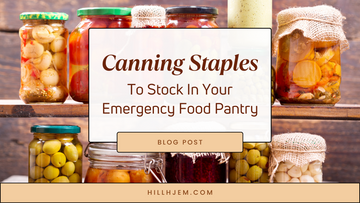
Imagine this: the power flickers, then dies. The news reports a storm's on the way, and store shelves might be bare for days. Don't panic! With a well-stocked pantry filled with canned goods you created yourself, you can face any challenge.
Canning is a superpower for emergency preparedness. It lets you preserve nutritious food at its peak freshness, ensuring you and your family have delicious, shelf-stable options for years to come.
In this guide, we'll explore why canning is great for emergencies and the essential canned foods you need for a well-stocked pantry.
Why Can for Your Emergency Pantry?
Canning boasts several advantages that make it ideal for emergency food storage:
➡︎ Long Shelf Life: Properly canned foods can last for years, some even up to a decade, without refrigeration. This ensures you have a reliable source of nutrition in the event of an extended emergency.
➡︎ Nutrient Rich: The canning process retains a significant amount of a food's vitamins and minerals. With canned goods, you're not sacrificing nutrition for convenience.
➡︎ Variety: You can can almost any fruit, vegetable, meat, or fish, allowing you to build a diverse pantry that caters to different dietary needs and taste preferences.
➡︎ Cost-Effective: Canning allows you to preserve food when it's in season and at its most affordable. This is a budget-friendly way to stock your pantry with high-quality ingredients.
➡︎ Self-Reliance: Canning empowers you to take control of your food supply. You're not reliant on grocery stores or commercially processed foods.
Essential Canned Foods for Your Emergency Pantry
Building a well-stocked emergency pantry with canned goods empowers you to be self-sufficient and prepared for any situation. Let's explore some essential canned foods to optimize your emergency stockpile:
Proteins:
Canned Meats (Tuna, Salmon, Chicken, Turkey)
Look for varieties packed in water for lower sodium content. These are excellent sources of complete protein, readily available for quick meals or adding to salads, sandwiches, or stir-fries. Stock a variety of types to cater to different preferences. Consider canned ham or roast beef for a heartier option.
Beans and Lentils
These budget-friendly powerhouses are packed with protein, fiber, iron, and B vitamins. Explore different varieties like kidney beans (perfect for chili), black beans (great for tacos and burritos), chickpeas (ideal for hummus and falafel), and lentils (add them to soups and stews). Pre-cooked canned beans save time while offering similar nutritional value.
Vegetables:
Tomatoes (Diced, Crushed, Whole Peeled)
A versatile pantry staple. Diced tomatoes are ideal for pasta sauce, chili, and soups. Crushed tomatoes work well for pizza sauce and stews. Whole peeled tomatoes add a chunky texture to stews and can be used for homemade tomato sauce. Consider fire-roasted tomatoes for a deeper, smokier flavor.
Corn
Choose options with low sodium content for a healthier choice. Canned corn adds a touch of sweetness and pops of color to salads, stir-fries, and casseroles. Experiment with different colored corn varieties like yellow, white, or even black corn for a unique twist.
Green Beans
A simple yet nutritious side dish, canned green beans are also perfect for salads and adding a vegetable element to soups and stews. Opt for varieties packed with a hint of dill or garlic for added flavor.
Mixed Vegetables
Canned mixed vegetables offer a convenient way to add a variety of vitamins and minerals to your diet. Look for options with lower sodium content and a mix that includes vegetables you enjoy, such as carrots, peas, corn, and green beans.
Fruits:
Fruits Packed in Water or Light Syrup
Minimize added sugar by opting for fruits canned in water or light syrup. Consider stocking applesauce for a quick and healthy snack, peaches and pears for adding sweetness to oatmeal or yogurt, and fruit cocktail for a refreshing treat.
Other Essentials:
Canned Soups and Chilis
Lifesavers for quick, easy meals. Look for low-sodium varieties with added vegetables, beans, or lean protein for a more complete and nutritious option. Consider vegetarian or vegan options for specific dietary needs.
Broth and Stock
Canned broth and stock form the flavorful base for soups, stews, sauces, and rice dishes. Consider chicken, beef, vegetable, or a low-sodium variety depending on your needs.
Canned Milk
Shelf-stable canned milk offers a viable alternative to fresh milk. Opt for evaporated milk for baking or coffee, or shelf-stable boxed milk for cereal or a quick beverage.
Additional Tips:
1. Don't forget to rotate your canned food stockpile! Regularly check expiration dates and use older items first. This ensures your pantry remains stocked with fresh, usable food.
2. Consider options for those with dietary restrictions. Look for low-sodium, gluten-free, or vegetarian canned goods to cater to various needs.
3. While some spices may lose potency over time, include a variety of dried herbs and peppers in your pantry. These can add flavor and variety to canned meals. Salt is a natural preservative and enhances taste; however, opt for iodized salt to ensure proper iodine intake.
4. Think outside the box! Consider shelf-stable condiments like pickles, peanut butter, or olives to add variety and flavor. Canned fruits like pineapple or mandarin oranges can add a refreshing touch to meals.
Knowing your family is safe and fed, no matter what happens, brings real peace of mind. By planning a bit and having some fun (maybe a little messy!) canning adventures, you can build a well-stocked pantry. It'll be there for you in tough times, a reminder you're prepared and you've got your loved ones covered.




